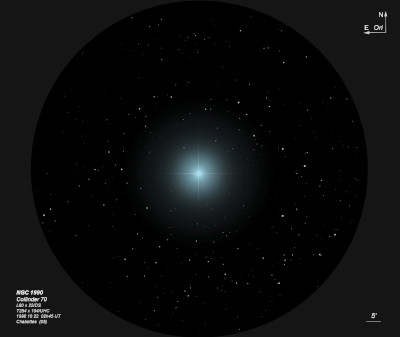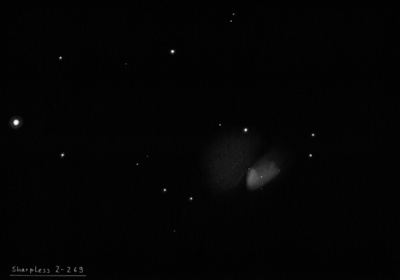Orion is the jewel of our winter sky and of all the constellations it is the most prominent, impossible to miss. The basic outline of the constellation is made up of seven stars. The striking line of three 2mag stars touching the celestial equator is the belt of Orion, lying in the central part of the constellation and peaking during late winter evenings and during the cold January. The stars of the belt are called Mintaka, Alnilam and Alnitak. Between them are a handful of 5-8mag stars, collectively referred to as Collinder 70. Orion's right arm is marked by the star Betelgeuse, the left by Bellatrix. Rigel is located in the right knee, Saiph in the left. Below the belt hangs a sword formed by a line of three stars. Around the star θ Orionis, which is a wide double star discernible in binoculars and whose western companion θ1 Orionis is a known multiple star of the Trapezium system, the Great Nebula in Orion (M42) is visible to the naked eye. Above the Betelgeuse-Rigel conjunction lies a triangle of three stars that represents the head of the hunter. On the left side the arc of fainter stars resembles a club, on the right a hunter's shield.
Orion extends on both sides of the equator, so it is visible in its entirety except for areas close to the poles from most viewing points on Earth. The constellation offers a wide and rich collection of cosmic attractions, whether for telescopes or small binoculars. The main exhibit is the Great Nebula in Orion, considered by many to be the most beautiful diffuse nebula in the sky and one of the most beautiful objects visible in binoculars. Many other nebulae can be seen in the infinitely large complex of gas and dust that covers most of Orion. The entire region is interspersed with the interstellar medium and is thought to be the birthplace of stars. Many of the double, triple and multiple systems are mostly blue-white in color because they are young stars that have only recently been born in the Orion complex.
In the northern part of the constellation, the two branches of the Milky Way from Gemini and Taurus merge, and further out the Milky Way begins to gradually expand. On the eastern side it reaches almost to Procyon of the Canis Minor in lateral view, while the western edge passes by the star Betelgeuse and is slightly more contrasted. Slightly to the northwest, the sparse open cluster Collinder 69 is visible to the naked eye, giving a hazy impression. It features a striking triangle of brighter stars λ (3mag), π1 and π2 Orionis (4mag). According to some observers, a large emission nebula, Sharpless 2-264, is visible to the naked eye in the very dark sky around them. This is surrounded by a ring about seven degrees in diameter consisting of a system of dark nebulae. It is no coincidence that it is therefore nicknamed, especially in photographs, the Ring around λ Orionis. But the truth lies somewhere in the middle. The nebula itself is covered by a mass of indistinguishable stars far beyond the limit of visibility, and the surrounding dark nebulae bordering the star cloud only give the impression of an artificial ring.
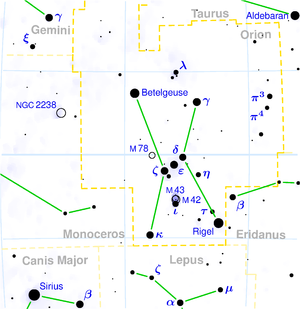
Rigel (β Ori) - It is usually the brightest star in the constellation, only occasionally surpassed by Betelgeuse during its greatest maximum. With its brightness of 0.14mag, it is the seventh brightest star in the sky. It is of spectral type B8, so its blue-white color is clearly visible to the naked eye. Rigel is 78 times larger and 12,000 times more luminous than our Sun, and it is located at a distance of 860 light-years.
Betelgeuse (α Ori) - This glowing red supergiant is a semi-regular variable star, with its brightness ranging from 0.4mag to 1.3mag in a period of approximately 5.7 years. However, it appears more orange in color. Betelgeuse is one of the largest stars visible to the naked eye. If it were located at the position of the Sun, its outer edge would extend all the way to the asteroid belt. It is located at a distance of 500-600 light-years.
Alnitak (ζ Ori) - The left star of Orion's belt is actually a triple star system. Close to the main component with a brightness of 1.9 magnitude, there is a companion with a brightness of 4.2 magnitude at a separation of 2.7 arcseconds. At an angular distance of 57 arcseconds, there is another star with a brightness of 9 magnitude, which is likely only projected near Alnitak. All components have a blue-white color.
Mintaka (δ Ori) - The right blue-white star of the belt near the celestial equator. It is one of the easiest distinguishable pairs - a telescope with a diameter of at least 5 cm will be sufficient. We will see the pale blue guide of magnitude 6.9 next to the main component at a separation of 52.6". It is likely a true binary star, even though the components are separated by half a light-year. Their mutual orbital period could therefore last up to a million years. The system is located at a distance of 2,350 light-years. Additionally, the main component is a variable star, but with a very small change in brightness (around 2.2 mag).
ι Ori - nice triple star suitable even for small telescopes. Next to the main white component (2.8mag) there is a faint blue companion (7.3mag) at a separation of 11.3". Another, reddish companion (11mag) is observed at a distance of 50" from this pair. The finder also shows a wide double star Struve 747, consisting of bright components with magnitudes 4.8 and 5.7.
λ Ori - The white companions have magnitudes of 3.5 and 5.6, with a separation of 4.4". Two additional, bluish companions are located at distances of 28" and 78" from this pair, respectively. λ Ori designates the head of Orion and forms an interesting triangle with π-1 and π-2 Ori. Both of them have a magnitude of 4.
σ Ori - With a telescope with a 5 cm objective diameter, we can detect two companions to the main white component with a magnitude of 3.81. The first companion has a magnitude of 6 and is located at a separation of 41". The second companion has a magnitude of 7 and is separated by 13". In a telescope with an objective diameter of around 15 cm, a companion with a magnitude of 10 is added at a separation of 11". Another companion with a magnitude of 6 is located very close to the main component, at a distance of 0.2", but only it is physically associated with the main component.
Trapéz - The "Theta system" is located in the heart of the Great Nebula in Orion and is one of the most famous multiple stars in the entire sky. Its four stars, ranging in brightness from 5th magnitude to 8th magnitude, form a quadrilateral called the Trapezium. Several 11th magnitude stars inside and around the quadrilateral undoubtedly belong physically to the Trapezium system. What's more, within a 5' area of the Trapezium, over 400 very faint stars are hidden, extremely young objects recently born from massive clouds of gas and dust. The stars of the Trapezium are exceptionally young, approximately 30,000 years old.
M 42
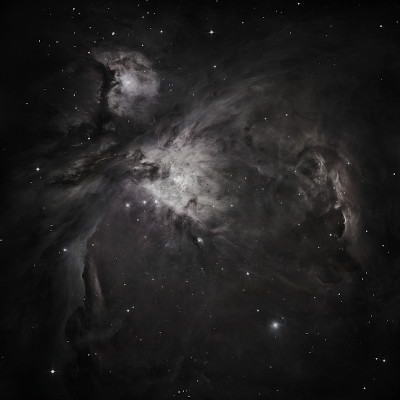 The following observational history of M42 = NGC 1976 = h360 is largely from Wolfgang Steinicke and http://seds.org/messier/more/m042_dis.html
The following observational history of M42 = NGC 1976 = h360 is largely from Wolfgang Steinicke and http://seds.org/messier/more/m042_dis.html
The Orion Nebula was probably discovered in November 1610 by Nicholas-Claude Fabri de Peiresc (1580-1637), a French lawyer, who turned his telescope (given to him by Galileo) to Orion and reported a "small illuminated cloud" near the middle star of Orion's Sword. This sighting, however, was not published, but only reported in Peiresc's personal documents and mentioned by Bigourdan in 1916. Jesuit astronomer Johann Baptist Cysat (1588-1657) of Lucerne was independently found it the following year. In 1619 he compared it to a comet he had observed in 1618. Cysat's work also did not get widely circulated but was found and reported by Rudolf Wolf in 1854. So, Dreyer included Cysat under the "Other Observers" column in the NGC. The first known (very rough) sketch of the Orion nebula was created by Sicilian astronomer Giovanni Batista Hodierna before 1654 and included three stars, probably Theta1, Theta2A and Theta2B. As he was little-known, his work was lost and not rediscovered until the 1980's.
None of the early discoveries were known when Christian Huygens rediscovered the nebula in 1656 with a 50mm refractor and published the first printed sketch which appeared in his "Systema Saturnium" in 1659, gaining credit for a long time as the discoverer, as reported by Halley and Messier. Huygens's sketch included 3 stars in the trapezium and the general shape of the bright central part of the nebula. Messier's more detailed sketch [made in 1769] showing the wings and the "fish's mouth" near the trapezium was published in 1771 (M?moires de l'Acad?mie Royale), though soon after William Herschel trained his large mirrors towards M42 (first observations in March 1774) and obtained much more detailed views. He called it "altogether the most wonderful object in the heavens." (16 Oct 1784)
M42 was one of the objects Lord Rosse attempted to "resolve" in 1845 and 1846 using his new 72-inch. After several bouts of poor weather, in February of 1846 he wrote "we are still in doubt as to the resolvability of the Nebula in Orion. The great instrument has shown us an immense number of stars in it, dense groups in the immediate vicinity of the Trapezium, but further evidence is I think wanting." A month later he was more convinced, writing in a letter "...there can be little if any doubt as to the resolvability of the nebulae...we could plainly see that all about the trapezium is a mass of stars; the rest of the nebula also abounding with stars, and exhibiting the characteristics of resolvability strongly marked." Most astronomers accepted these claims, though a few such as Wilhelm Struve challenged the alleged resolution. Clearly the Orion was a poor choice to decide resolvability as there are many stars associated with it, but the Irish observers also claimed resolvability for the Crab Nebula and the Ring Nebula (especially by Romney Robinson). George Bond, son of William Cranch Bond and Director of the Harvard College Observatory, claimed to have confirmed Rosse's resolution using HCO's new 15" refractor. In his first examination on 21-22 Sep 1847, he scrawled in his notebook, "Resolved. Mottled. Abundance of Stars." He reported to Harvard's president that "You will rejoice with me that the great Nebula in Orion has yielded to the powers of our incomparable telescope!"
Ronald Stoyan, in "Sketching the Orion Nebula" (Astronomy, Feb 2013), stated that Bond determined the positions of all stars he could perceive through the 15-inch (HCO refractor) in a 20' radius around the Trapezium. Working through seven winter seasons from 1857 to 1864 and finally reaching a field of 3.36? square, he catalogued 1,101 stars as faint as 15th magnitude, observed numerous various stars, and described M42 in metriculous detail like no one before. But above all, he sketched what he saw at the eyepiece - the first complete and accurate "image" of this region. His eye for detail was so that that the engraver [for the 1867 "Observations upon the Great Nebula in Orion" in http://adsabs.harvard.edu/full/1867AnHar...5D...3B] had to look through the telescope to adequately reproduce Bond's impressions. The result was the most accurate and elaborate astronomical drawing ever done. Bond's cousin, American astronomer Edward S. Holden, said in 1882 that it was the "most satisfactory representation of any celestial object." [A biography of George Bond, as well as his sketch of the Orion Nebula is at http://ejamison.net/bond.html]
The Orion Nebula was reported early on by various observers as possibly variable, with changes in both shape and brightness. Edward Holden gives a comprehensive history of observations of the Orion Nebula by 44 individuals, from Cysat in 1619 to Draper in 1880. See http://openlibrary.org/books/OL7237514M/. Henry Draper took the first photograph of the Orion Nebula on 30 Sep 1880 with an 11-inch Clark refractor, though the resolution and details were very poor. In 1882-83, Ainslee Common obtained a number of impressive long-exposure photographs using his 36-inch silver-on-glass reflector (first to show details not visible naked-eye) and in 1889 Isaac Roberts produced some excellent wide-field photographs of M42 using a 20-inch Grubb reflector.
400/500mm - 17.5" (10/12/85): best emission nebula in northern sky, fantastic view under all conditions, bright colored wings sweep to the east and south. The remarkable structure is difficult to describe but includes bays, filaments, knots, nebulous stars and a huge outer loop. Definite colors are visible including pale greens and pinks. Highlighted by the Trapezium which contains six stars and appears to reside in a darker hollow. The bright portion surrounding Theta probably has the highest surface brightness of any HII region in the sky with an "electric" appearance. Dark streaks and a dark wedge = "fish's mouth" intrudes on the NE side. Using an H-Beta filter, the nebulosity significantly dims in general but there is one outer wing or loop on the west side (oriented N-S) which obviously increases in contrast with the filter!
900/1200mm - 48" (4/1/11): the Trapezium was first object viewed while the sky was still darkening. The "H" star (discovered by Barnard in 1888 with the Lick 36" was easily visible without reference to a chart, though I apparently missed the G star inside the Trapezium and a fainter companion to H at 1.3" separation. The "E" component was seen for the first time with a vivid orange color! In addition, due north of the A-E pair is a faint double star near the edge of the darker central pocket containing the Trapezium. On the opposite side (SE) of the Trapezium (at the edge of the inner pocket) are a wide pair of stars (~20") oriented E-W with possibly a third extremely difficult star between and a bit further east. Although I didn't take notes or try to sketch the main features of M42, there were several faint pink or red stars peppered over the glow of the nebula!
Notes by Steve Gottlieb
M 43
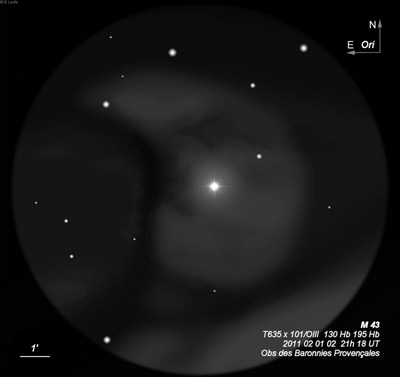
Jean-Jacques d'Ortous de Mairan discovered M42 = NGC 1982 = H III-1 around 1731 with a small, long-focal length refractor (18 or 22 ft). It's sometimes referred to as "De Mairan's Nebula". This prominent patch in the Orion Nebula complex was not mentioned by Piersec or sketched by Huygens. William Herschel catalogued it as H III-1 on 3 Nov 1783 (third night of sweeps), noting "vF, S, mE. In the Large nebula."
200/250mm - 8" fairly large, irregular, protrudes to the NE, includes a bright star.
300/350mm - 13.1" large detached piece of M42, mottled outer region, very bright center. Has a large rotated "comma" shape with a dark indentation on the east side. A mag 8 star is embedded.
Notes by Steve Gottlieb
M 78
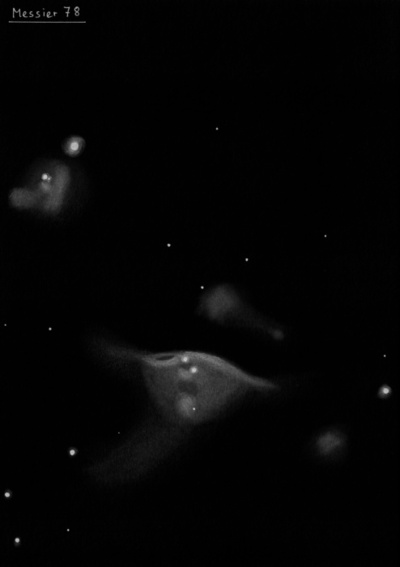
Pierre Méchain discovered M78 = NGC 2068 = h368 in March 1780. On 19 Dec 1783 William Herschel described M78 as "Two large [bright] stars, well defined, within a nebulous glare of light resembling that in Orion's sword. There are also three very small [faint] stars just visible in the nebulous part which seem to be component particles thereof. I think there is a faint ray near 1/2 deg long towards the east and another towards the south east less extended, but I am not quite so well assured of the reality of these latter phenomena as I could wish, and would rather ascribe them to some deception. At least I shall suspend my judgement till I have seen it again in very fine weather, tho' the night is far from bad." M78 was the first reflection nebula that was discovered.
On 9 Jan 1856 the observer on the 72" (R.J. Mitchell) wrote, "in finder eyepiece a B oval neb with n and nf edges brightest and best defined, and sp edge fading away gradually; with higher power there is seen a decided darkness at and between the stars. I can confirm previous observation as to the curve formed by the brightest part of the neb."
Joseph Turner sketched the nebula in Dec 1876 using the 48" Great Melbourne Telescope - plate III, figure 31 at www.docdb.net/history/texts/1885osngmt________e/lithograph_m_3_31.php, as well as Pietro Baracchi on 8 Dec 1884.
200/250mm - 8" (12/6/80): bright reflection nebula, large, NW edge brighter and sharper, elongated, roughly rectangular, wide pair of mag 10 stars involved, striking. Brightest in a group of reflection nebulae.
400/500mm - 17.5" (12/20/95): very bright reflection nebula surrounding two mag 10.5 stars with a mag 13 star involved at the south end. Large, irregular shape, 6'x4'. Brightest along the north side which has a sharply defined slightly bowed-out edge with one of the mag 10.5 stars near the midpoint. A brighter knot is just following this star. The nebula irregularly fans out towards the south and fades with no distinct borders but tapers somewhat at the south edge.
17.5" (2/1/92):very bright, surprisingly large, 6'x4'. Surrounds two mag 10 stars although the nebulosity extends further to east of these stars. Also a mag 13 star is embedded in the SE end. Brighter and sharper edge gently curves from west to north side. Appears to fan out to the SE where the nebula gradually fades into background. Brightest in a group of reflection nebulae including NGC 2064 7' SW and NGC 2067 6' WNW.
Notes by Steve Gottlieb
NGC 2024
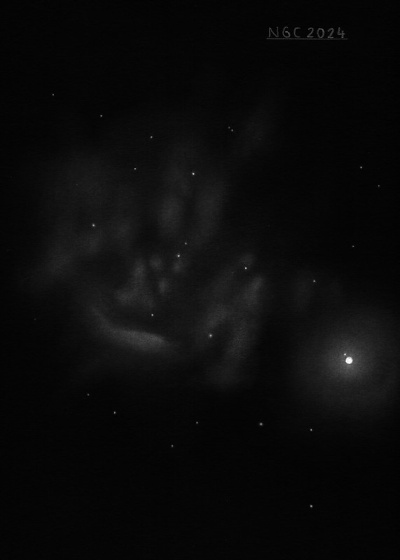
William Herschel discovered NGC 2024 = H V-28 on 1 Jan 1786 (sweep 506) and recorded "a wonderful milky nebulosity, divided into 3 or 4 large patches including a dark space, the whole cannot take up less than half a degree; but I suppose it to be much more extensive." A month later (sweep 518) he noted "Wonderful black space inlcuded in nebulosities."
The following information is from Wolfgang Steinicke's book "Observing Cataloguing Nebulae and Star Clusters. NGC 2024 was independently found by Brorsen in 1850 with a small refractor at Senftenberg Observatory and announced in AN that "I have found a very faint, very extended, pretty irregular nebula, located about 15 minutes east of Zeta Orionis, which is listed neither in the catalogue of the younger Herschel nor in Messier's." In 1856 Marth noted that Brorsen's object was William Herschel's H. V-28. This was another case where the observer only checked the Slough catalogue and didn't refer to WH's catalogues, which only had relative offsets and not absolute positions.
Heinrich d'Arrest sketched the nebula in 4 sections. The brightest section (labeled A) is just west of the main dust lane. This object was observed 13 times at Birr Castle from 1873-1878 by Lawrence Parsons (with the 36-inch), Ralph Copeland and Dreyer, and stars "in an about the neb" were sketched and accurately measured.
Garrett Serviss (Pleasures of the Telescope, 1901) wrote "Just to the left of Zeta, and in the same field of view with a very low power, is a remarkable nebula bearing the catalogue number GC 1227. We must use our five-inch on this with a low power, but with Zeta out of the field in order to avoid its glare. The nebula is exceedingly faint, and we can be satisfied if we see it simply as a hazy spot, although with much larger telescopes it has appeared at least half a degree broad. Tempel saw several centers of condensation in it, and traced three or four broad nebulous streams, one of which decidedly suggested spiral motion."
200/250mm - 8" fairly easy in very dark skies, the strip along the east side is longer with a possible gap at the base of "U" in the southwest corner. The center is definitely darker than the background sky.
8" (10/4/80): fairly bright, large. Consists of two parallel strips separated by a dark lane. Appears possibly broken (gap) at the base of "U". Best view with a UHC filter.
400/500mm - 17.5" (2/8/86): bright, very large. Consists of two main parallel sections elongated SSW-NNE separated by prominent detailed dark lanes. Excellent structure with ragged edges, gaps, streaks, rifts and various brightness levels. The eastern strip has one or two indentations or a scalloped inner edge. The inner edge of the connecting strip has a sharply defined edge and the gap at the base connecting the brighter western section is obvious. Zeta Orionis lies 15' NE detracts and the best view is unfiltered.
Notes by Steve Gottlieb
NGC 2174
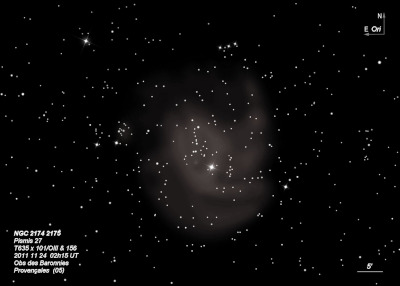
Édouard Stephan discovered NGC 2174 = St IX-7 on 6 Feb 1877. His description doesn't refer to the entire nebula but rather a small patch of nebulosity (without the accents): "excessive., excess. faible (a peine observable); a l'interieur d'un triangle forme par trois petites etoiles."
He gives a 1878 position of 06 02 07.47 +20 40 54.4 which precesses to 06 09 24.0 +20 39 53 (2000), and falls on the northwest side of the nebula. This probably needs a small correction in declination based on his reference star, but is still accurate enough to clearly identify a small brighter patch of nebulosity. His three stars are mag 13-14 and the knot of nebulosity is quite prominent on the DSS just following the middle of these three stars. This star has a position of 06 09 21.9 +20 39 30 (2000) and Stephan's knot appears only 30-40" in diameter.
300/350mm - 13.1" (1/18/85): very bright with filter, very large, surrounds a mag 8 star, sky very dark off west side. West of the star the nebula is mottled and streaky with a bright region near the north edge.
400/500mm - 17.5" (1/16/02): at 64x and OIII filter, this is a beautiful, detailed nebulosity surrounding a mag 8 star (SAO 78049), extending at least 20' diameter. The OIII filter gives a dramatic contrast gain. With averted vision and careful viewing, the outer borders extend to ~25'. Structure includes interior streaky dark lanes visible to the west of the star. The rim is slightly brighter or has a higher contrast on the western edge but slightly more nebulosity is visible on the following side of the star.
Without a filter at 64x, I was surprised to immediately notice a moderately bright 3' round glow, situated ~11' NNW of SAO 78049 near the NW edge of the main glow. Interestingly, this patch of nebulosity is more prominent than the main body without a filter and is probably the section of the HII complex visually discovered by Stephan! It seemed quite strange that this patch had such a different filter response and dimmed significantly with the OIII (mainly reflection component?). A curving arc of stars is situated along the north side of the glow. The entire nebula is situated among a scattered group of stars, which is often mistaken for NGC 2175. Located 1.4 degrees ENE of Chi(2) Orionis.
17.5" (2/28/87): very large, irregular nebulosity surrounding mag 8.0 SAO 78049. Dark lanes are evident west of the star, appears very streaky. A bright small unresolved knot is 3.2' ENE of the bright star using an OIII filter [this is NGC 2175].
Notes by Steve Gottlieb
NGC 2169
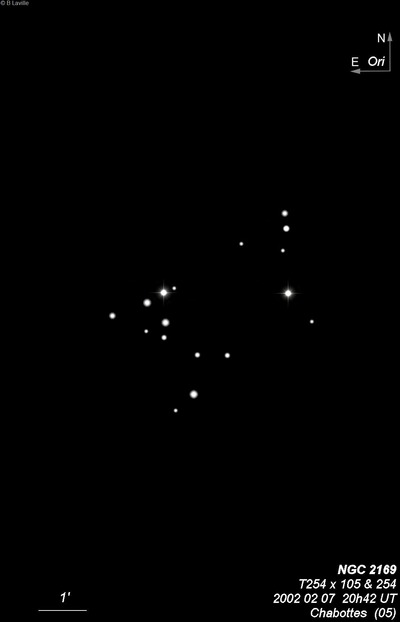
William Herschel discovered NGC 2169 = H VIII-24 = h379 on 15 Oct 1784 (sweep 293) and recorded as "a small cluster of pretty large white stars, prettily arranged, not many of them." On 24 Dec 1786 (sweep 662) he noted "a cl of brilliant stars, not many in number, but pretty much compressed; with a vacancy in the middle."
By analyzing William Herschel's early "reviews" of bright stars (before his systematic sweeps), which resulted in the discovery of many double stars, Wolfgang Steinicke found that Herschel first discovered the cluster on 12 Oct 1782 using his 6.2" reflector.
400/500mm - 17.5" (1/19/91): 20 stars mag 7.5-13 in bright, distinctive group. Fairly small, about 6' diameter, not rich. The stars are divided into two main subgroups - along the west side is a string of six stars aligned N-S in a very shallow "V" asterism. The northern two stars in this string form the wide double ∑844 = 8.8/9.9 at 24" and less than 2' S is mag 8.7 SAO 95271. The eastern subgroup consists of 9 stars forming a distinctive triangle outline and includes the close double star ∑848 = 7.5/8.0 at 2.5". The brighter stars form a fairly distinctive "37" pattern! Located 0.9 degrees WSW of Xi Orionis.
Notes by Steve Gottlieb
NGC 1973
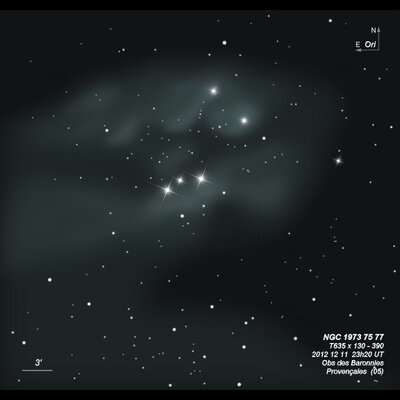
Heinrich d'Arrest discovered NGC 1973 on 16 Dec 1862 within NGC 1977. He calls it a nebulous mag 8-9 star and his single position corresponds with HD 36958 = SAO 132302 = KX Ori.
300/350mm - 13.1" bright reflection nebulosity surrounding 7th magnitude SAO 132302. See NGC 1977.
600/800mm - 24" (1/22/15): locally bright (reflection?) nebula surrounding mag 6.9 HD 36958, embedded within the much larger NGC 1977 complex. Extends ~4' diameter in a circular glow, though the perphery is not well defined. A fainter star 34" NNE is involved in the nebula and at moments seemed to be encased in its own small halo. NGC 1975 is 4.4' NE.
Notes by Steve Gottlieb
IC 434
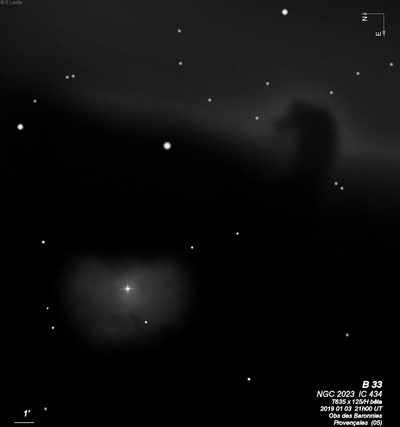
Williamina Fleming discovered IC 434 on Harvard College Observatory plates in 1883. Edward Pickering announced the discovery (along with a number of other Orion nebulae) in the 1890 Harvard Annals publication (1890AnHar..18..113P). She also described the dark notch (later dubbed the "Horsehead") as "A large nebulosity extending nearly south the Zeta Orionis for about 60'. More intense and well marked on the following side with a semicircular indentation 5' in diameter 30' south of Zeta. All good plates of this region show this object, and it has been used here as a test for some time." Dreyer didn't mention the "indentation" in the IC description.
Harold Corwin comments that "Some people have suggested that it was actually found by William Herschel. This is not true; WH's comment (see Latusseck, J. Astron. Data 14, 4, 2008 where it is reprinted) "Wonderful black space included in Nebulosities" refers to NGC 2024, not to IC 434."
But Wolfgang notes that on 1 Feb 1786 (sweep 518), WH recorded a large region of nebulosity extending roughly 2° north-south, not far east of IC 434. He noted "I am pretty sure the places of which these are the boundaries are all full of diffused milky nebulosity; but notwithstanding I used every means of ascertaining it by motion of the telescope, my range was neither far enough, nor sufficiently quick to put it beyond doubt. He assigned it internal discovery number (1321), which became H. V 35 (first of 4 different fields associated with that designation). Wolfgang Steinicke feels it may apply to IC 434, though Herschel's RA is about 3 minutes too large, so this identification is very uncertain.
300/350mm - 13.1" (1/11/86): using an H-beta filter IC 434 appears a very faint, very large, very elongated strip of nebulosity running south of Zeta Orionis for almost one degree in a N-S direction. There is a well-defined sharp edge along the east side while the west side fades off into the background. Contains the famous dark nebula B33 = "Horsehead Nebula" as a dark "notch". IC 434 extends beyond NGC 2023 off the east edge and the star density drops off significantly east of IC 434 whereas a number of faint stars are pepper the field to the west of IC 434. This is one of the few emission nebulae that responds very well to a H-Beta filter. Extremely difficult without filter.
13.1" (1/18/85): visible with direct vision with H-Beta filter and striking with averted. The snout was suspected. The contrast between B33 and the sky was high with the background jet black and sharply outlined against the easy glow of IC 434. Best view with 24mm.
400/500mm - 17.5" (12/26/00 and 12/28/00): at 100x using an H-beta filter, the huge IC 434 strip was very prominent and easy to follow south from Zeta Orionis throughout the entire 50' field of view. The boundary was razor-sharp along its eastern edge against a background sky darkened by the H-beta filter. The Horsehead was very easy to view as a nearly black, semi-circular 4' indentation that protruded into the nebulosity. With averted vision there was a short extension or knob on the north side. This forms the snout of the horse and with concentration faint nebulosity is visible just below (east) of the snout.
17.5" (10/8/88): easily held with direct vision using the H-beta filter. The head or snout protrudes to the north.
17.5" (9/14/85 and 10/12/85): the Horsehead Nebula appears as a jet black dark nebula using an H-beta filter at 84x superimposed against the fairly prominent emission nebula IC 434. Appears as a semi-circular indentation or "bite" of 5' diameter along the sharply defined eastern edge of IC 434 "strip" which extends through field in a N-S orientation. Significant contrast gain with and H-Beta filter which renders the background sky and B33 extremely dark. Difficult to see the "snout" feature which protrudes to the north but it is detectable. Mag 8.5 SAO 132451 lies 8' N.
600/800mm - 24" (2/13/18): I was surprised to easily pick up the IC 434 strip extending south of Zeta Orionis unfiltered at 124x (21mm Nagler). Although the Horsehead wasn't prominently visible, I could also see the notch unfiltered!
24" (1/21/12): the view of the Horsehead through a 24" f/4.1 Starmaster using a Collins I3 image intensifier mated with a narrowband H-alpha filter at the Mauna Kea visitor center (9300') was absolutely stunning. The outline stood out in extremely sharp relief like a photograph and the dark cloud was pitch black against the bright background. I'm not sure of the magnification used but the field was 30' or less and the Horsehead was large enough to show exquisite detail in the outline.
Notes by Steve Gottlieb
NGC 1980
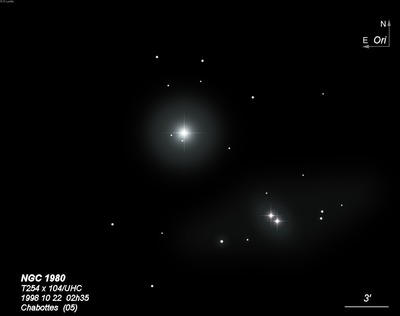
William Herschel discovered NGC 1980 = H V-31 = h361 on 31 Jan 1786 (sweep 517) and noted "Iota Orionis seems with its neighbouring stars to be involved in milky nebulosity; but it is so faint and the number of stars makes the field so bright, that I cannot assure myself; though I compared this spot with the preceding and following ones." He observed it again on sweep 529 and recorded "Iota certainly affected, but no more that what the tinge of the bottom in this neighbourhood will account for." John Herschel noted on 8 Jan 1831 (sweep 218), "Iota Orionis involved in a feeble neb 3' diam."
Iota Orionis was first observed with Lord Rosse's 72" on 28 Jan 1849. Either Lord Rosse or assistant Johnstone Stoney recorded, "Dark space in the nebula containing nearest companion; light nearly equable; sketch made (by Stoney); 3-feet telescope employed. All the stars in the neighbourhood are nebulous, of these two a little sp, last seem to have dar spaces as in figure."
William Lassell made an observation on 7 Jan 1853 with his 24-inch equatorial reflector and reported, "Surveyed this star for some time without any impression of a nebula about it. At length I began to conceive that the glare around it, which I had attributed to the splendour of the star, might be really nebulous; and on further looking attentively at the stars, I could fancy they were on a black ground in the midst of the nebulae; but, without the suggestion of Lord Rosse's drawing, I think the appearance would have escaped me." Observing with the 48" Melbourne telescope on 3 Jan 1886, Pietro Baracchi commented, "Uncertain - Is it nebulosity or stray diffused light from the stars?"
It is very possible that WH observed just scattered light around Iota, since the very southern end of M42 has a very low surface brightness and would be difficult to distinguish among the several bright stars in the field. Wolfgang Steinicke favors interpreting NGC 1980 as an illusion (personal email on 21 Mar 2015), though Harold Corwin is not convinced (personal email of 23 Mar 2015).
300/350mm - 13.1" (1/28/84): very faint, large nebulosity of low surface brightness surrounding Iota Orionis (V = 2.8). Very difficult to distinguish from glare of Iota. M42 lies 30' N.
Notes by Steve Gottlieb
NGC 2022
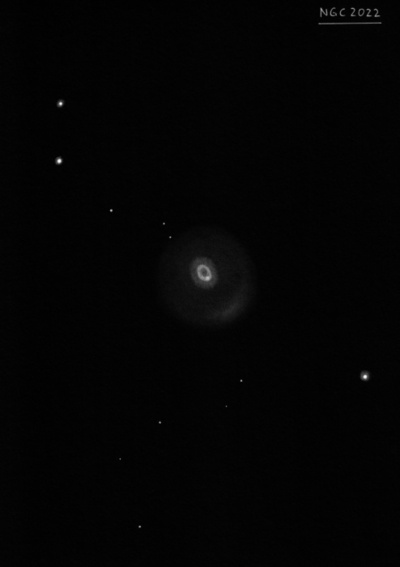
William Herschel discovered NGC 2022 = H IV-34 = h365 on 28 Dec 1785 (sweep 496) and described it as "cB, vS, like a star with a large diameter. With 240 it appeared almost like a planetary nebula, but very ill defined, and little elongated. Nearly of equal brightness throughout, except at the edges." John Herschel wrote (sweep 121, 19 Jan 1828), "Planetary neb, a little indistinct at the edges; rather oval and perhaps of a mottled light."
NGC 2022 was observed 5 times with Lord Rosse's 72", often in an attempt to resolve it, and the following notes were recorded:
11 Dec 1850: "It is I am nearly sure resolvable, probably it is a glob Cl. At times I fancied the centre a little darker and a star in the p part."
23 Oct 1851: "I strongly suspect annular, r[esolvable], one star especially seen in the p part.
28 Dec 1853: "...a B patch or a star?, it is near the edge of the neb. Some dark spot or spots certainly seen and at times I had the suspicion of a concentric ring or rings."
5 Jan 1877: "Seems a glob Cl, stars seen sparkling in it, oval sp nf. Edges v diffuse, especially sf, np edge more sharp. Proportion of diameters about 7:10."
William Lassell observed NGC 2022 in Jan. 1853 from Malta with his 24-inch equatorial reflector and commented, "a singular curdled-looking object, slightly and irregularly elliptical, with a sort of cordon [outer shell] running round parallel, but a little outside of its margin." A sketch was included in his 1854 MRAS paper (figure 2). Father Secchi sketched a slightly darker center in his 1856 "Osservazioni di Nebulose". In 1862 and 1863, Lassell aos observed the planetary through his 48-inch on Malta and noted "with 1060x some brighter patches or nodules seem to exist in it, but nothing more can be made out.” His sketch showed the central star and a thin outer ring separated by a thin dark gap.
Based on a Crossley photograph, Curtis (1918) reported, "Sharp stellar nucleus about mag 13, surrounded by an elliptical ring 22"x17" in outside dimensions in pa 29°. Outside this is an oval disk of fainter matter 28"x27". The brightest parts are the two masses at the ends of the major axis of the inner ring."
300/350mm - 13" moderately bright, high surface brightness. No internal structure was visible.
400/500mm - 17.5" (2/2/02): immediately picked up at 100x as a very small, bluish-gray "egg" of fairly high surface brightness. Good contrast gain with OIII filter. At 380x (unfiltered), it appeared as fairly bright, clearly elongated SSW-NNE, ~27"x20". The surface brightness was irregular or mottled with a slightly brighter rim and darker center giving a weakly annular appearance. The rim seems to have a couple of slightly brighter spots and the ends of the minor axis are slightly dimmer. No sign of a central star.
17.5" (12/8/90): fairly bright, slightly elongated 4:3 ~SSW-NNE, about 30" diameter. Appears slightly annular at 412x with a brighter rim. No central star seen at this power.
600/800mm - 24" (1/25/14): at 500x appeared as a fairly bright knotty annulus, slightly elongated SW-NE with fascinating structure. The rim was clearly brighter along an ~200° arc running from the southwest counterclockwise to the northeast. Very small brighter knots were definite at the SW and NE ends and perhaps a slight brightening at the NW edge. In general, though, the rim appeared mottled and sparkling though clearly dimmer along the southeast side, giving a "C" appearance. At 750x, the darker center was also irregular in surface brightness and occasionally, an extremely faint central star sparkled.
900/1200mm - 48" (2/21/12): at 488x, this bright, double-shell planetary contains a bright oval ring oriented SSW-NNE, ~23"x18". The annulus is fairly thin with a relatively large, darker central hole, though the contrast is fairly low. At the exact center is a faint central star (close to 16th mag?). The ring has an irregular surface brightness; slightly brighter at the ends of the major axis, particularly the SW end (knot or thicker?), and slightly fainter along the minor axis. Surrounding the ring is a fainter and rounder outer shell, ~30" diameter. The outer shell was surprisingly prominent and exhibited a pinkish hue.
Notes by Steve Gottlieb
NGC 2023
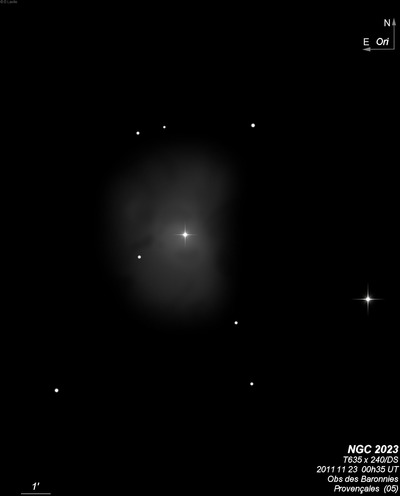
William Herschel discovered NGC 2023 = H IV-24 on 6 Jan 1785 (sweep 352) and described in his 1791 paper "On Nebulous Stars" as "A bright star with a very considerably milky chevelure; a little extended, 4 or 5' in length, and near 4' broad; it loses itself insensibly. I suspected some extensive milky windings in the neighborhood but could not verify them; other stars of equal magnitude are perfectly free from this chevelure." He later noted "The connection between the star and the chevelure cannot be doubted, from the insensible gradation of its luminous appearance, decreasing as it receded from the centre."
200/250mm - 8" moderately bright, surrounds a mag 8 star.
300/350mm - 13.1" fairly prominent nebulosity surrounds mag 7.8 SAO 132464. The Horsehead nebula lies 15' SW.
600/800mm - 24" (1/1/19): at 200x; very bright, very large, irregular glow surrounding mag 7.8 HD 37903, ~7' diameter, ragged periphery, high surface brightness! The reflection nebula has a fairly well defined border on the west side. A superimposed mag 12.5 star is 2.4' ESE and there is a bite or divot into the nebulosity around this star. Very low surface brightness glow, though, is evident extending further SE and E of this star.
Notes by Steve Gottlieb
NGC 1788
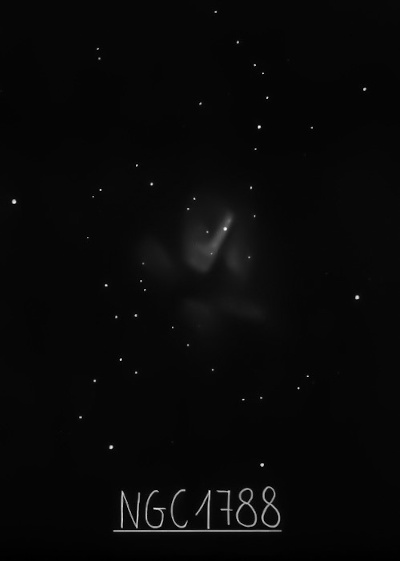
William Herschel discovered NGC 1788 = H V-32 = h347 = Sw. II-30 = Sw. VII-9 on 1 Feb 1786 (sweep 518). His description reads, "cB, vL, milky, diffused and vanishing, very near and sf a bright star, the milkiness diffused and vanishing." On 26 Nov 1786 (sweep 640) he recorded "vL, milky; seems to have some untied stars towards the southern part of it; some other stars are in it, but plainly unconnected. 3 or 4' dia. vF except about the united stars." Joihn Herschel wrote on 11 Feb 1830 (sweep 233), "A *10m with a neb south-following; pos 138 from *; the centre of the neb is like a misty *12 or 13m, or perhaps 2 or 3 st 15m; a small * to the south of neb makes an isosceles triangle. Place that of the *10m." This reflection nebula was observed 21 times at Birr Castle beginning in 1849 (the 1880 publication lists 10 of these).
Lewis Swift found this reflection nebula on 24 Nov 1884 and apparently felt that nebulosity surrounding the 10th mag star on the west side was distinct from Herschel's nebulosity, reporting it as a "nova" in his 2nd discovery list (#30) and his 7th list (#9).
200/250mm - 8" (12/6/80): moderately bright reflection nebula, large, brightest in center, two stars involved, extends to east.
400/500mm - 17.5" (2/9/02): at 144x this is a bright reflection nebula involving two mag 10 and 11.5 stars. The nebulosity is irregularly bright in a 4'x3' region elongated NW-SE and locally very bright in a knot surrounding the mag 11.5 star near the SE end. Enhanced by a Deep Sky filter at low power. The brighter mag 10 star ~2' NW has a faint companion and is also encased in the glow as well as a couple of other fainter stars. A faint extension fans out to the NE from the mag 11 star and some haze is suspected to the south, increasing the size to ~7' and involving a few additional stars. NGC 1788 is located within a bright trapezoid consisting of three mag 8.5-9 stars and a mag 10 star (sides of 9'-13')
17.5" (12/23/89): bright, fairly large, locally very bright surrounding a mag 12 star on the south end. This star appears slightly nonstellar as difficult to separate from bright haze. Extends NW to include a mag 10 star and three other faint stars are involved in the brightest portion. Very faint nebulosity also extends to north and further east.
Notes by Steve Gottlieb
NGC 1999
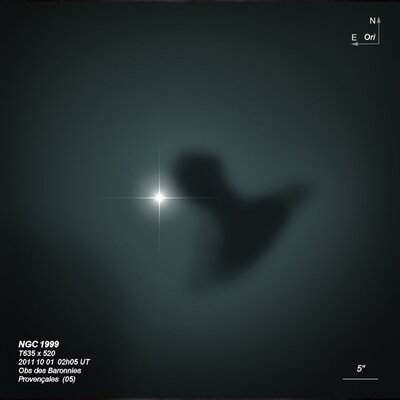
William Herschel discovered NGC 1999 = H IV-33 on 5 Oct 1785 (sweep 458) and called it "a star with a very strong burr all around." On 1 Nov 1785 (sweep 468) he noted "vB or rather a nucleus with a milky nebulosity chiefly on the preceding side, of no very great extent." In his 1814 PT paper WH included NGC 1999 under the section "Of Stars connected with extensive windings of nebulosity" and noted "a star situated upon a ground of extremely faint "milky nebulosity diffused over this part of the heavens, has "a milky chevelure surrounding it, which is brighter than "the nebulosity of the ground; but which loses itself imperceptibly in the extreme faintness of the general diffusion of the nebulous matter." He used this object in his argument that the star was formed by the law of gravitation from the nebular material. His rough sketch shows the off-central star superimposed, though no dark patch. Ralph Copeland, observing with Lord Rosse's 72" on 15 Nov 1873, recorded a "*9m with nebulosity in which there is a vacuity preceding the star. It looks like a comet coiled round into a ring nebula [See Pl I.]. So, clearly the dark patch was quite evident.
Based on photographs taken at the Helwan Observatory in Egypt between 1914-16 with the 30" Reynolds reflector, NGC 1999 was described as "!! vB, pL, a dense globe with an absolutely dark triangular hole cutting into it." Although the dark patch is generally assumed to be a dark globule, a 2010 paper "er ist wahrhaftig ein Loch im Himmel. The NGC 1999 dark globule is not a globule" (http://adsabs.harvard.edu/abs/2010arXiv1005.2202S), suggests that "the dark patch is in fact a hole or cavity in the material producing the NGC 1999 reflection nebula, excavated by protostellar jets from the V 380 Ori multiple system." See http://www.esa.int/esaCP/SEMFEAKPO8G_index_0.html for more.
200/250mm - 8" (11/28/81): small circular nebulosity surrounds a mag 10 star.
300/350mm - 13.1" (2/25/84): a curving dark lane is visible west of the central star with faint nebulosity west of the gap.
400/500mm - 17.5" (2/22/03): remarkable, bright 2' reflection nebula surrounding mag 10.5 V380 Orionis (emission-line star). At 220x, a prominent, curving dark patch or globule wraps around the star along the west side. Two of the brightest Herbig-Haro objects are close south, with HH 2 lies 4.3' due south and fainter HH 1 2.5' is SSW.
17.5" (2/8/90): bright, high surface brightness emission nebula surrounding a mag 10 star, round, about 2' diameter. There is a striking curved irregular dark patch or globule along the west side of the central star that is remarkable at high power. The nebulosity is weakest on the SE side of star. Easily takes 220x-280x.
17.5" (2/22/86): bright, round nebula around a 10th magnitude illuminating star. A eye-catching, curved, irregular dark patch is NW of the central star within the nebulosity.
900/1200mm - 48" (10/25/11): stunning view at 375x and 488x. The high surface brightness reflection nebulosity surrounding the mag 10.5-11.0 illuminating star (V380 Ori) was intensely bright. The dark splotch (possibly a Bok globule) that blots out a portion of the nebula just west of center appeared sharply etched into the nebulosity and formed a "keyhole" or "anvil" outline with a thin extension to the east and a thicker north-south flat section on the west. The contrast of this dark nebulosity was extremely high and appeared virtually identical to images.
Notes by Steve Gottlieb
NGC 1981
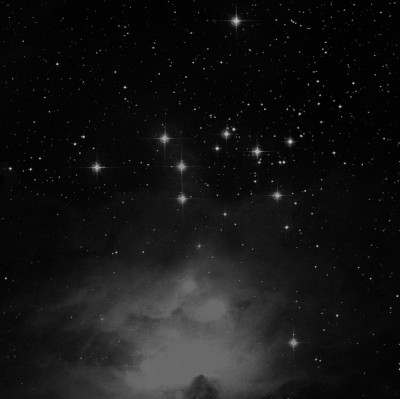
John Herschel discovered NGC 1981 = h362 on 4 Jan 1827 (sweep 41) and described "a coarse and por but very splendid cluster of large stars; a beautiful object." His position corresponds with mag 6.5 HD 37040 = ?750 = mag 6/8 at 4" on the NE side of the cluster.
But by analyzing William Herschel's early "reviews" of bright stars (before his systematic sweeps), Wolfgang Steinicke recently found (email Oct '16) that Herschel first discovered the cluster on 23 Oct 1780 using his 6.2" reflector.
200/250mm - 8" bright cluster with about two dozen stars mag 6 and fainter. Very large, scattered. Includes ?750 = 6/8 at 4". To the south is another group of bright stars surrounded by the emission nebula NGC 1973-1977.
400/500mm - 18" (1/17/09): this very bright, scattered 25' cluster is situated just north of the cluster/emission nebula NGC 1973/75/77 and both appear to be part of the same complex at 73x. Contains 7 stars mag 6-7.5 and a dozen stars mag 9 or brighter. Most of the remaining stars are much fainter and more concentrated on the west side and streaming off the northwest end.
600/800mm - 24" (1/22/15): at 200x; HD 37040 = ?750 = 6.4/8.4 at 4" on the northeast side of the cluster was easily resolved and ?743 = 7.7/8.3 at 1.8", a tight pair in the western side was just resolved. The cluster filled most of the 30' field.
Naked-eye - (10/23/11): visible as a hazy glow just north of the three "stars" in the sword. None of the individual mag 6.5 stars are resolved naked-eye as they are two tightly grouped, but the cluster is easily resolved in binoculars.
Notes by Steve Gottlieb
NGC 2194
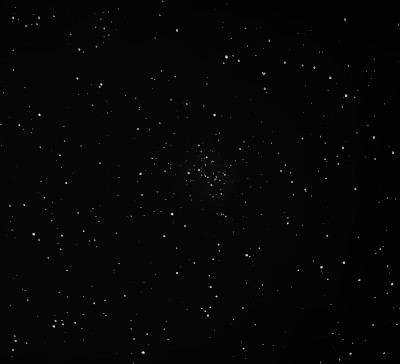
William Herschel discovered NGC 2194 = H VI-5 on 11 Feb 1784 and described a "a cluster of very close stars. Rich and of large extent, i.e. about 7 or 8' or more." On 24 Dec 1786 (sweep 662) he recorded "a beautiful cluster of very compressed small stars of several sizes, gradually most compressed in the middle, irr R, 12 or 15' in diameter." In his 1814 PT paper he considered this as an example of a cluster in an advanced state of insulation, "not much differing from a globular figure."
Adolph Petersen independently found the cluster in 1849 but with a poor position. The position was accuratelly measured by d'Arrest on 18 Sep 1862 and by Vogel on 7 Dec 1869. Dreyer missed the equivalence with H. VI 5 and entered d'Arrest's observation as GC 5380 in his Supplement.
300/350mm - 13.1" (1/18/85): at least 50 stars in a 5' region including many mag 14/15 stars, very rich with averted. Includes a few brighter stars on the east edge.
Notes by Steve Gottlieb
NGC 2186
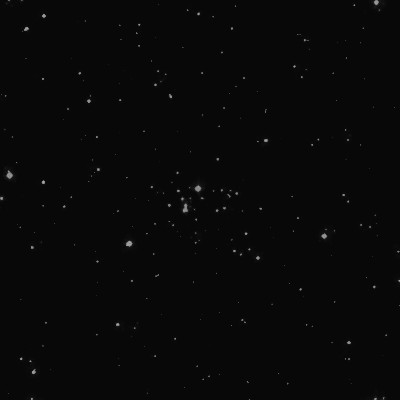
William Herschel discovered NGC 2186 = H VII-25 = h384 on NGC 2186 (sweep 512) and logged "a cluster of pretty compressed stars of several sizes, 4' or 5' diameter wth extensively straggling ones." John Herschel described on 2 Feb 1831 (sweep 320), "a pretty rich, comp cl, one st = 9, 3 or 4 = 11, and many 12...15. Place that of double star h2288."
400/500mm - 17.5" (1/19/91): at 140x about 30 stars in a 4' diameter including three mag 10 stars. A prominent group is on the north side, highlighted by mag 10 HD 253336 and 50" to its SE is a double star HJ 2301 = 11/12 at 10". A clump of mag 13/14 stars is just west of this subgroup and a triangular group of stars is at the southwest end.
Notes by Steve Gottlieb
NGC 2112
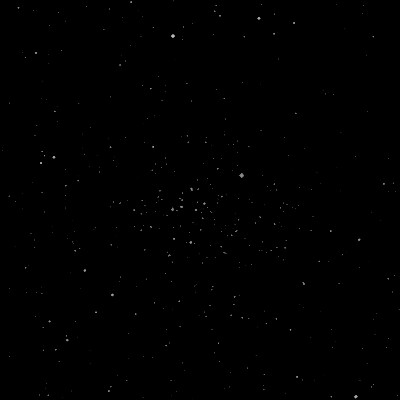
William Herschel discovered NGC 2112 = H VII-24 = h371 on 1 Jan 1786 (sweep 506) and recorded "a cluster of pretty compressed pS scattered stars." The summary description (including a 2nd observation) in his PT catalogue and "with many eS suspected between them. 7' or 8' diameter." On 23 Nov 1827 (sweep 107), John Herschel recorded "the 2nd and brightest star of a poor straggling cl 10 or 12' long."
200/250mm - 8" (1/1/84): 12 faint stars mag 12/13 in cluster. Also includes one bright mag 10 star at NW edge.
400/500mm - 17.5" (2/8/91): three dozen stars over unresolved haze, roughly 10' diameter. The brightest star (mag 10) is at NW edge. Includes a string of five mag 12-13 stars on the north side but most stars are very faint. This cluster is fairly rich but not dense. Barnard's Loop passes just west of the cluster heading south and NE where it is brightest!
Notes by Steve Gottlieb
NGC 2071
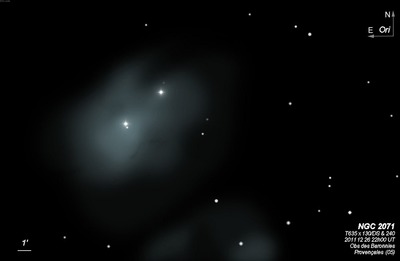
William Herschel discovered NGC 2071 = H IV-36 on 1 Jan 1786 (sweep 506) and recorded "a star affected with vF extensive milky chevelure. The star not quite central." On a second observation on 22 Feb 1786 (sweep 526) he noted again "a star with a milky chevelure. vF and extensive." In his PT paper of 1791 he mentions "As by the word chevelure I always denoted something relating to a center, the connection cannot be doubted." His position is fairly accurate.
200/250mm - 8" faint reflection nebula. Located 15' NNE of M78. Surround the southeast member of a mag 10 double star.
400/500mm - 17.5" (12/20/95): fairly bright reflection nebula surounding a mag 9.5 star, 3.5' diameter. Shape appears irregular (although no distinct borders) but extends more to the south side of the star, which has a faint companion close south. A second mag 9.5 star (not involved) lies 3.5' NW. The field is strangely lacking in stars due to obscuration.
17.5" (2/1/92): fairly bright reflection nebula surrounds a mag 10 star although extends farther south. A second mag 13 star is embedded just south of the bright star. The round outline gradually fades into the background. A mag 10 star is 3.5' NW but the field is strangely devoid of stars due to obscuring dust. Located 15' NNE of M78.
Notes by Steve Gottlieb
NGC 2141
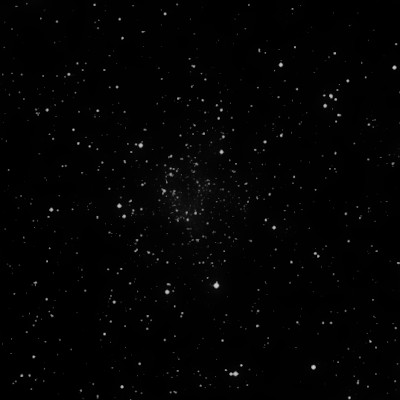
E.E. Barnard discovered NGC 2141 in Jan 1883 with his 5-inch refractor. His announcement note in Sidereal Messenger, Vol 3, p9 titled "A New and Faint Nebulosity" gives an accurate position and describes a "very faint nebulosity. It lies a little over 3/4° north of Mu Orionis, and requires a low power to be seen at all. With my 5-inch refractor and a power of 30, it is quite distinct; but high powers diffuse it greatly. There is a faint star in its center, and several others on its border, about 2' diameter. I have repeatedly seen this nebula since January 1883."
400/500mm - 17.5" (12/8/90): 20-25 faint stars mag 13-15 at 220x over extensive haze. Located within an incomplete circle of several brighter mag 11-12 stars about 8' diameter.
Notes by Steve Gottlieb
IC 2162
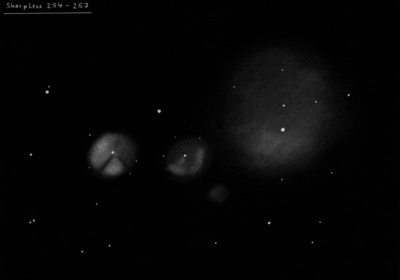
E.E. Barnard discovered IC 2162 visually on 30 Nov 1888 with the 12-inch refractor at Lick Observatory. He first logged in his notebook "Found a v. difficult neb close f and involving a 10m star." He added the comments "vF neb, pL, roundish, densest part following the 10m star." His field sketch and approximate offset from mag 5.9 HD 42954 pins down the identification with Sh 2-255 (eastern of a pair of faint HII glows). Barnard notified Dreyer directly of the discovery.
400/500mm - 17.5" (3/2/02): at 100x unfiltered, IC 2162 was visible as the following of two faint, round glows surrounding mag 10.5-11 stars. IC 2162 = Sh 2-255 is the brighter and larger of the pair, nearly 4' in diameter and quite symmetric. Just under 5' due west is a separate 3' fainter glow (Sh 2-257). This pair of low excitation emission knots is situated midway between two mag 6 stars with a 50' separation near the edge of the 20mm Nagler field. Close southwest of Sh 2-257 is a very faint patch of nebulosity, Sh 2-256, but this was not seen visually, nor was the larger HII region Sh 2-254, a low surface brightness glow to the west (11' diameter).
600/800mm - 24" (2/5/13): IC 2162 = Sh 2-255 is the brightest and easternmost of four round low-excitation emission glows with Sh 2-257 and Sh 2-254 lined up roughly to the west. Using 125x (21mm Ethos) and H-beta filter, it appeared as a moderately bright, round glow, ~3.5' diameter, surrounding the mag 11.6 exciting star. Sh 2-257 lies 5' W, and is a similar size, but surrounds several stars and has a lower surface brightness. Sh 2-256 is a very faint detached glow off the SW side.
Notes by Steve Gottlieb
IC 423
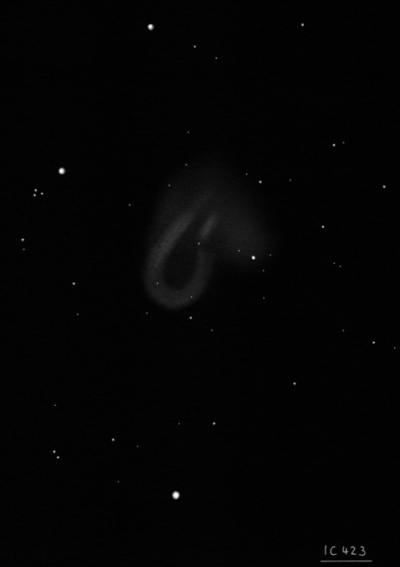
Williamina Fleming discovered IC 423 = HN 58 on 27 Jun 1888 during a photographic survey of the M42 region at the Harvard College Observatory. She noted a "irregular oval ring having diameters 3' by 5'. The position angle of the larger axis is about 165°." Edward Pickering published the discovery in the 1890 Harvard Annals publication (1890AnHar..18..113P) and is credited with the discovery in the IC. Fleming examined photographs taken with the Bache telescope, an 8-inch f/5.5 doublet covering 10 degrees square, with a magnifying glass.
400/500mm - 17.5" (12/26/00): fairly faint, large, slightly elongated NW-SE, ~5' diameter. A couple of mag 12.5 stars are superimposed. The edges fade into the background. Photographically, this reflection nebula has an irregular ring shape. Located 28' SE of mag 2.2 Delta Orionis (top star in Orion's Belt). Nearby IC 424 to the NE was not noted, though observed on 2/19/09.
Notes by Steve Gottlieb
NGC 1662
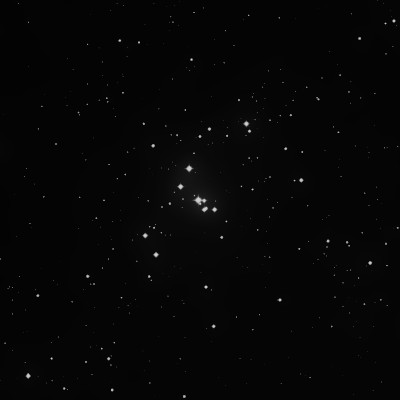
William Herschel discovered NGC 1662 = H VII-1 = h332 on 18 Jan 1784 (sweep 80) and found "a cluster of large scattered stars, they are visible in the finder." His Philosphical Transactions description also using a later sweep, added "10' or 12' in extent, with a vacancy in the middle." His position was 30 seconds of time too far east, but John Herschel measured an accurate position on 19 Jan 1828 (sweep 121) and described, "A cluster of stars 11 and 12m, three L and five small stars. Query if the right object." It is.
400/500mm - 17.5" (12/9/01): striking group of ~40 stars within 15' including a number of mag 9 stars. Many of the brighter stars are arranged in a "boat" shape with the bottom of the boat consisting of a string oriented NW-SE. In the middle is a mast, perpendicular to the longer stream of stars. The "mast" includes the multiple star HJ 684, a bright quadruple of mag 8-10 stars with a 5th fainter star (8.5/10.3 at 24" and 9.6/12.5 at 10").
Notes by Steve Gottlieb
NGC 2175
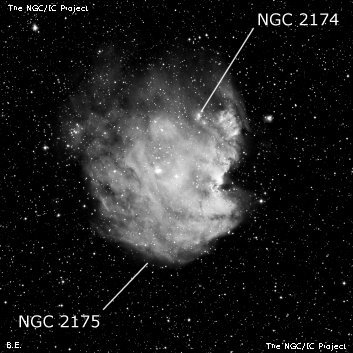
Carl Christian Bruhns discovered NGC 2175 = Au 21 in 1857 using a comet-seeker at the Berlin Observatory. His position corresponds with mag 7.6 HD 42088. Arthur Auwers described this nebula on 24 Feb 1861 with the 6" Heliometer at Konigsberg Observatory as "a considerable area of milky, faint light, extended about 8' north-south and 25' east-west. In the brightest part is the 8m star." Heinrich d'Arrest made 3 observations using the 11-inch refractor at Copenhagen in Jan 1865 and wrote "the extraordinarily large, faint nebula is one of the objects which are difficult to see with higher magnification. It took a long time to find it." (translations from Wolfgang Steincke). E.E. Barnard also commented "In the finder (3 1/4-inch) [of the 12-inch Lick refractor], the 8m star is seem to be surrounded by a group of small stars - the whole being a loose cluster. The cluster is enveloped in feeble nebulosity." See my notes on NGC 2174.
400/500mm - 17.5" See description for NGC 2174. Although the scattered group of stars involved with the HII region is identified as NGC 2175, the NGC description (from Auwers and Bruhns) does not refer to a cluster but rather a "*8m in neb (Auw No 21)". The position given is 10' S of NGC 2174 and 16 tsec east. But in the IC 2 notes and correction, Dreyer gives a correction in RA from Bigourdan to 06 01 32. This places NGC 2175 at 06 09 52 +20 29.1 (2000) and is just 1' S of the brightest section of the nebula (about 3' ENE of mag 8 SAO 78049). The scattered group is catalogued as Cr 84.
Notes by Steve Gottlieb
NGC 1975
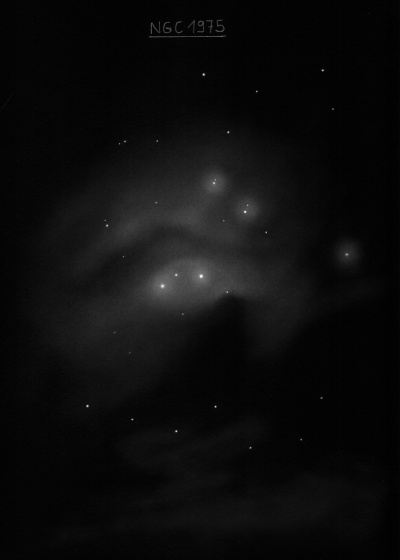
Heinrich d'Arrest discovered NGC 1975 on 3 Oct 1864 and called it a "bright double star involved in nebulosity within V. 30 [NGC 1977]." His single position corresponds with the double star ?746 = 10.4/10.7 at 14" in the northern part of the nebula.
300/350mm - 13.1" see description for NGC 1973. This is the faintest portion of the NGC 1977 complex and appears large and elongated, including a mag 11/11 double star.
600/800mm - 24" (1/22/15): bright 2' reflection nebulosity surrounding HD 294263 (triple star) within the NGC 1977 complex. The two brighter components form ?746 = 10.4/10.7 at 14", with a third fainter star 12" SW. Also a 4th star is ~35" NW of the pair and within the glow. The nebula seems more centered on the northeast component of ?746. Brighter NGC 1973 lies 4.5' SW and the entire field is awash in nebulosity.
Notes by Steve Gottlieb
NGC 1977
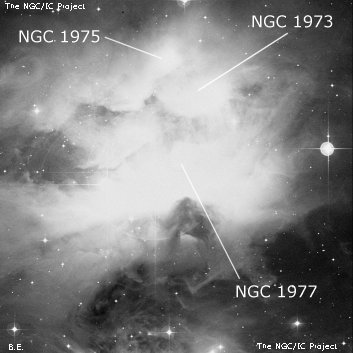
William Herschel discovered NGC 1977 = H V-30 on 18 Jan 1786 (sweep 510) and recorded "I returned to the c's Orionis [1 and 2 c Orionis], and the stars about them; and found them as suspected involved in very visible, and unequally bright milky nebulosity. I am pretty sure this joins to the great nebula [M42]." NGC 1977 is generally taken as the brightest portion around 42 and 45 Orionis, though Herschel's description really applies to the entire nebula and scattered group of stars.
300/350mm - 13.1" extensive bright field of nebulosity including NGC 1973 and NGC 1975, very large, elongated ~E-W. Involves several bright stars including 42 Orionis (V = 4.7) and 45 Orionis (V = 5.3). Irregular and detailed with detached segments. Extends north and south beyond 42 Orionis. Located north of M42 and south of the bright cluster NGC 1981.
600/800mm - 24" (1/22/15): NGC 1977 is a prominent 20' field of nebulosity involving 42 Ori (V = 4.6 and a challenging 1.2" pair), 45 Ori (V = 5.2) and mag 7.3 HD 37058 on the south side and NGC 1973 (KX Ori) and NGC 1975 (?746) in the northern half. The entire complex is irregularly luminous but locally brightest around these stars and dimmer in the central region. The southern portion is brighter and elongated E-W with an irregular outline. On the southeast side is an extension and the northeast section ends near a 30" unequal pair of stars. See NGC 1973 and NGC 1975 for separate descriptions.
Notes by Steve Gottlieb
NGC 1819
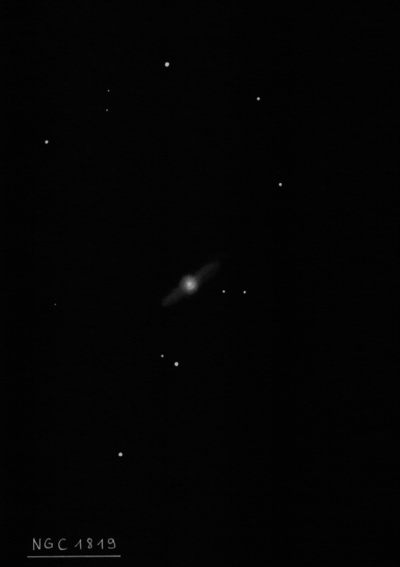
Lewis Swift discovered NGC 1819 = Sw. III-35 on 26 Dec 1885 with the 16" refractor at the Warner Observatory. His position is 10 tsec west of UGC 3265 = PGC 16899. Bigourdan measured an accurate position on 6 Dec 1888 (repeated in the IC 2 Notes section).
300/350mm - 13.1" (11/29/86): faint, very small, bright core, elongated NW-SE. Located 12.5' S of mag 8 SAO 112508.
Notes by Steve Gottlieb
IC 412
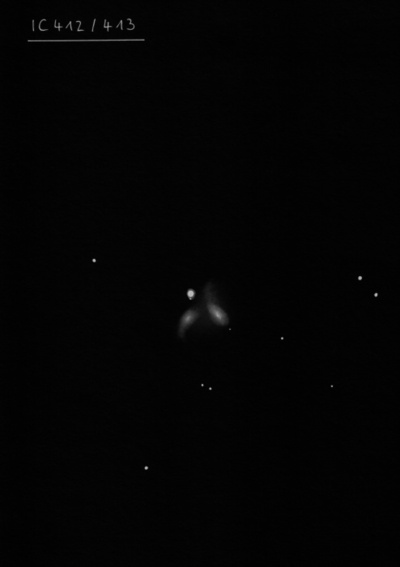
400/500mm - 17.5" (12/26/00): this is the northwest member of an unusual close pair of interacting galaxies with IC 413 -- just 35" separation (in PA 115°) and both members appearing to extend from a mag 12 star (30" from centers to star)! Both galaxies are faint, very small, slightly elongated, ~25"x15", with small brighter cores. IC 412 is elongated SSW-NNE and 30" SW of the mag 12 star - with the NE end just west of the star. Located 6' SSW of mag 7.6 SAO 112679 and 14' WSW of the (32") mag 5/7 double 23 Orionis. A third galaxy, IC 414, is in the field 8.5' S, forming the poor galaxy cluster WBL 114.
600/800mm - 24" (1/12/13): both members of this interacting pair (VV 225) are fairly faint, small, roughly 20"-25" in size, and each contains small bright cores. IC 412, the northwest component, is larger and more elongated , roughly 5:3 SW-NE, 25"x15". IC 413 is just off the ESE side, 35" between centers. A mag 12.3 star is 30" ENE (at the north edge of IC 413). The stretched spiral arm or tidal tail to the north was not seen. The pair is 14' WSW of the bright double 23 Ori = STF 696 (5.0/7.2 at 32"). IC 414 lies 8.5' S.
Member of a group (WBL 114 = LGG 130) at a distance of ~180 million l.y. with UGC 3294, 34' WNW. This spiral appeared moderately bright and large, contains a very diffuse, low surface brightness halo perhaps 1.3'x0.6' NW-SE with a small brighter core that increases to a stellar nucleus. The outer halo changes appearance with averted vision (no sharp edge) based on what part catches my averted vision. Situated 4' W of mag 6.5 HD 34959 and the glare affects the view -- best with star placed outside the field.
900/1200mm - 48" (10/27/19): IC 412 and 412 form an interacting pair (VV 225) with the centers separated by 35" WNW-ESE. A mag 12.3 star only 30" NE forms a small triangle with the two galaxies. At low power (375x), IC 412 appeared moderately bright, fairly small, elongated 3:2 SW-NE, 25"x16", with a bright elongated core or bar. We didn't try higher power to resolve the spiral arm extending north.
Notes by Steve Gottlieb
UGC 3258
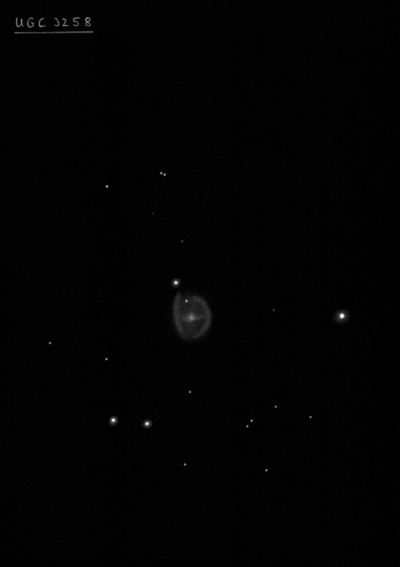
600/800mm - 24" (2/18/20): at 375x; fairly faint, fairly small, slightly elongated, 35"x25", low surface brightness, small, slightly brighter nucleus. A mag 13 star is 30" NNE of center, just off the edge and a mag 14.5-15 star is superimposed just inside the NNE edge [11" from center]. Located 16' SW of mag 6.7 HD 33647.
Notes by Steve Gottlieb
NGC 2163
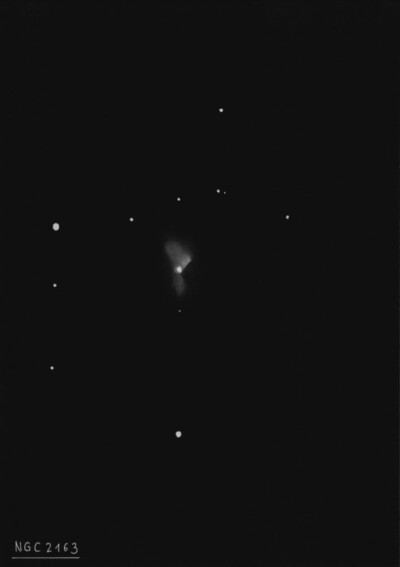
Édouard Stephan discovered NGC 2163 = St IX-6 on 6 Feb 1874 with the 31-inch reflector at the Marseille Observatory and recorded "eF, E, dif, *11 attached south." He observed it again on 6 Jan 1878. In compiling the NGC, Dreyer accidentally copied the declination of NGC 1741 (Stephan's previous entry, IX-5). Dreyer later caught and corrected his error in the IC 2 Notes/Corrections section (Dreyer added the comment "my mistake"). The correction was missed by most later cataloguers though Esmiol's 1916 re-reduction of Stephan's positions also gives the accurate position. As an example, in 1922 Edwin Hubble called it "A bright, uncatalogued nebula similar to NGC 2245" and Sven Cederblad listed it as "anonymous" object (#62). So, both were obviously thrown off by Dreyer's mistake. I uncovered that E.E. Barnard independently discovered it on 2 Sep 1888, though initially mistook it for Faye's Comet, which he was searching for.
Skiff recomputed Stephan's original position using precise coordinates for his offset star HD 41787 as 06 04 53.62 +18 40 08.7 (1950). At this exact location is the reflection nebula Cederblad 62 at 06 04 53.17 +18 39 55.0 just 0.45 tsec of RA and 13".7 in declination from Stephan's original coordinates. Besides the excellent positional match, Stephan described NGC 2163 as "elongated with *11 attached south" and visually this nebula appears to extend more prominently north of the mag 11.5 (central) star. On the POSS, Ced 62 is an interesting bipolar nebula with two symmetrical funnel-shaped jets extending north-south from the central star.
More recently, Cederblad 62 wasn't referenced as a NGC object in the first edition of the Uranometria 2000.0, Sky Atlas 2000.0 or the Sky Catalogue 2000. The RNGC identifies this object as nonexistent and furthermore reverses the sign of the declination. In addition, a poor RA was given for Ced 62 in Sky Catalogue 2000 and it was misplotted on the Uranometria 2000 (first edition) too far east, though the position was corrected in the second edition. The Millenium Star Atlas labels this object Ced 62 at the wrong position.
400/500mm - 17.5" (1/9/98): moderately bright reflection nebula surrounding a young mag 11 star (HBC 193). The brightest portion of the nebula is noticeably elongated N-S from the central star and 2'-3' in length tapering towards the star. The northern extension has a slightly higher surface brightness. Located 3' W of a mag 9 star. Observed at 220x without filtration.
17.5" (12/23/92): faint, fairly small, elongated 5:2 N-S, ~2.5'x1.0', fairly high surface brightness. A mag 11 star is at the south tip of the bright portion and a small very faint extension appears south of this star. Located 3' W of mag 9 HD 41787. Two mag 13 stars are 1' NE and 1' N and a mag 10 star is 5' S. An evenly matched mag 10.5/10.5 double at 12" separation lies 8' WSW. This reflection nebula doesn't respond to a Daystar 300 or OIII filter. Listed as nonexistent in the RNGC due to an error in declination in the NGC. Plotted as Ced 62 in U2000.
Notes by Steve Gottlieb
IC 426
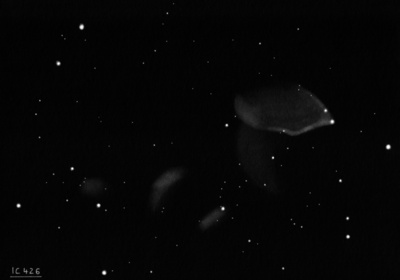
Williamina Fleming discovered IC 426 = HN 57, along with IC 423 and 424, on 27 Jun 1888 during a photographic survey of the M42 region at the Harvard College Observatory. Edward C. Pickering reported the discovery in the 1908 Harvard Annals publication and he is credited with the discovery in the IC. IC 423 was described as a "faint nebula about 5' in diameter."
400/500mm - 18" (11/22/03): at 115x, surprisingly large reflection nebula just following a mag 8.6 star. Appears ~7'x5' in diameter and oval E-W, though the outline is ragged. There are a number of brighter stars nearby and the nebula is situated northeast of a distinctive N-S chain of 5 stars mag 8.6-10. A distinct border runs E-W just following the mag 8.6 star. An OIII filter killed the nebula, though I didn't try either a UHC or H-beta filter. Located 1° NNE of Alnilam (middle star in Orion's belt).
Notes by Steve Gottlieb
Sh2-276
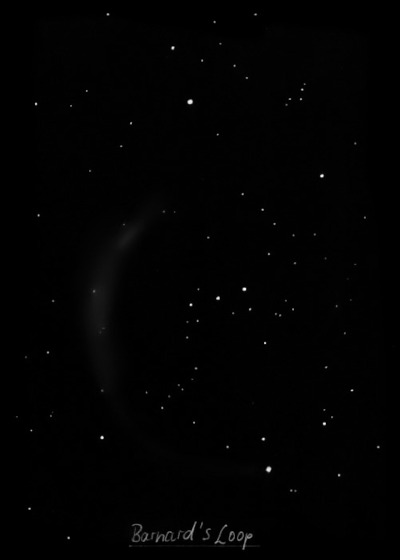
| Type | BN [E] |
| RA | 05:54:24.0 |
| Dec | -01:00:00.0 |
| major_axis | 600.0' |
| minor_axis | 60.0' |
| position_angle | 150.0 |
| mag | 7.0 |
| surface_bright | 18.2 |
HCG 34
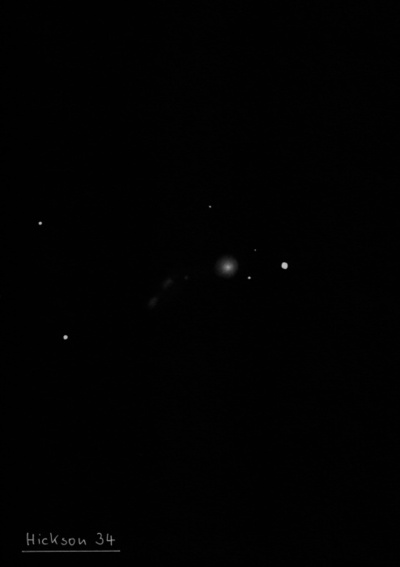
| Type | GALCL [E1] |
| RA | 05:21:47.4 |
| Dec | +06:40:37.0 |
| major_axis | 96.0'' |
| mag | 12.7 |
| surface_bright | 99.9 |
Abell 12
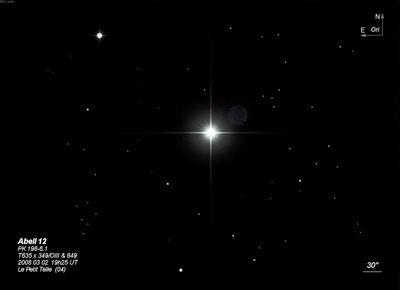
| Type | PN |
| RA | 06:02:20.0 |
| Dec | +09:39:14.0 |
| major_axis | 36.0'' |
| mag | 13.9 |
| surface_bright | 12.6 |
H 3-75
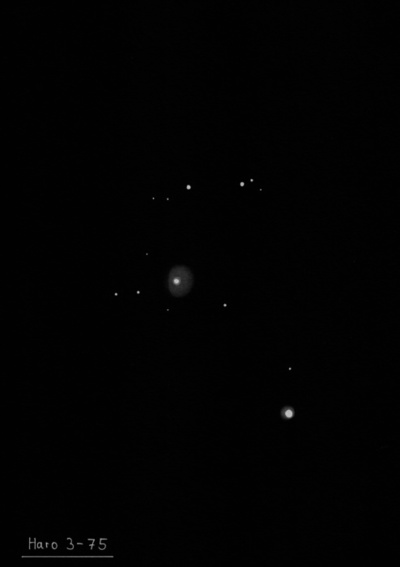
| Type | PN |
| RA | 05:40:45.0 |
| Dec | +12:21:23.0 |
| major_axis | 24.0'' |
| mag | 13.9 |
| surface_bright | 11.6 |
Abell 539
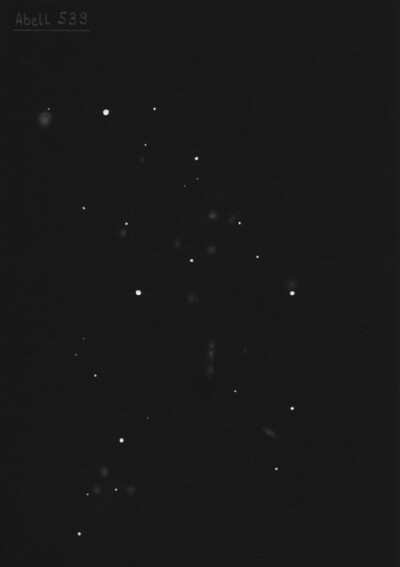
| Type | GALCL [12III] |
| RA | 05:16:42.0 |
| Dec | +06:27:60.0 |
| major_axis | 16.8' |
| mag | 14.4 |
Abell 10
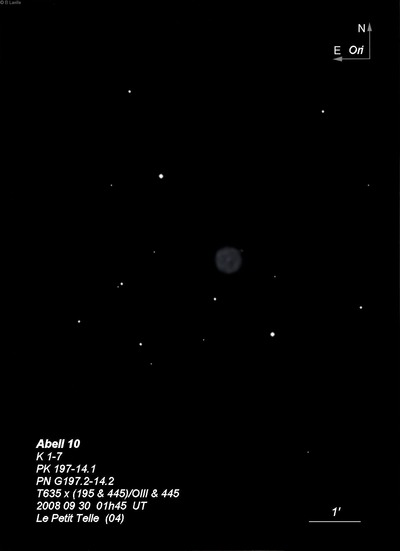
| Type | PN |
| RA | 05:31:45.5 |
| Dec | +06:56:02.0 |
| major_axis | 36.0'' |
| mag | 15.2 |
| surface_bright | 13.7 |
Abell 13
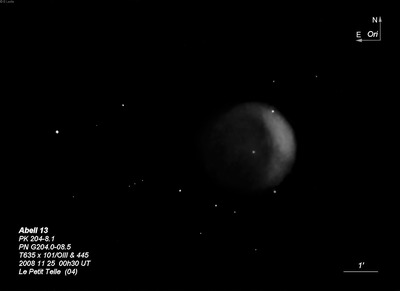
| Type | PN |
| RA | 06:04:47.9 |
| Dec | +03:56:36.0 |
| major_axis | 2.2' |
| mag | 16.0 |
| surface_bright | 17.5 |
Abell 14
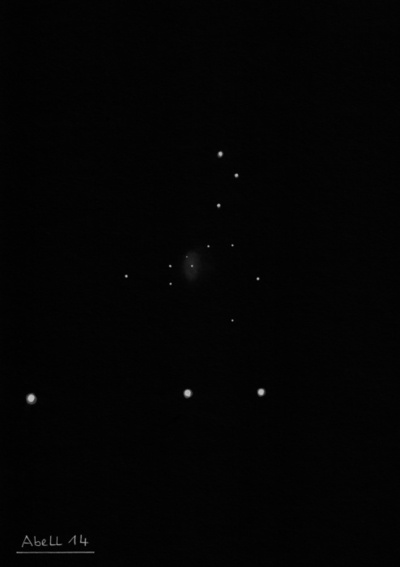
| Type | PN [2c] |
| RA | 06:11:08.7 |
| Dec | +11:46:44.0 |
| major_axis | 42.0'' |
| minor_axis | 30.0'' |
| mag | 18.2 |
| surface_bright | 16.6 |
B 33
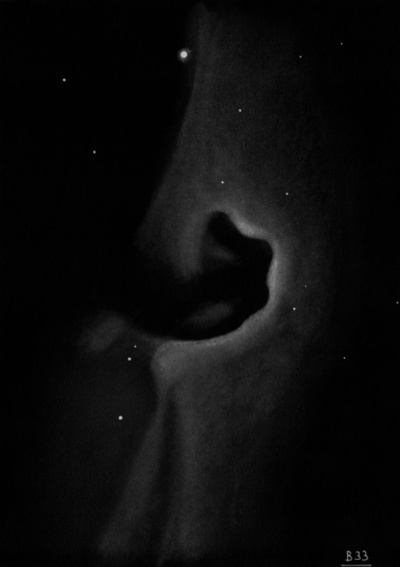
| Type | DN |
| RA | 05:40:54.0 |
| Dec | -02:28:00.0 |
| major_axis | 6.0' |
| minor_axis | 4.0' |
| mag | 79.9 |
| surface_bright | 79.9 |
Sh2-261
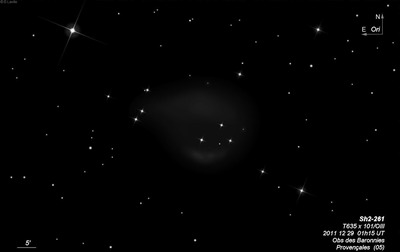
| Type | BN [E] |
| RA | 06:08:57.1 |
| Dec | +15:48:13.0 |
| major_axis | 45.0' |
